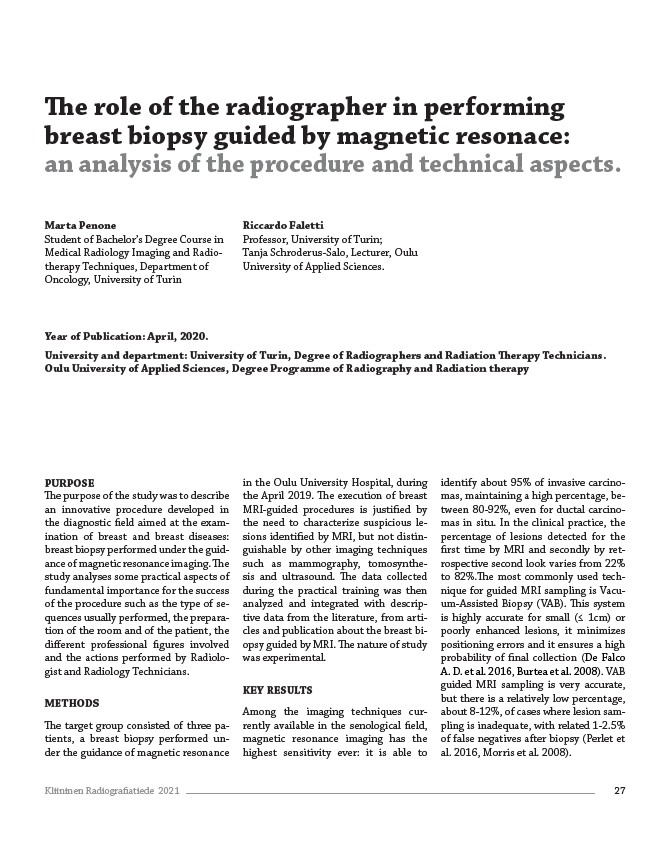
The role of the radiographer in performing
breast biopsy guided by magnetic resonace:
an analysis of the procedure and technical aspects.
Marta Penone
Student of Bachelor’s Degree Course in
Medical Radiology Imaging and Radio-therapy
Techniques, Department of
Oncology, University of Turin
Riccardo Faletti
Professor, University of Turin;
Tanja Schroderus-Salo, Lecturer, Oulu
University of Applied Sciences.
Year of Publication: April, 2020.
University and department: University of Turin, Degree of Radiographers and Radiation Therapy Technicians.
Oulu University of Applied Sciences, Degree Programme of Radiography and Radiation therapy
PURPOSE
The purpose of the study was to describe
an innovative procedure developed in
the diagnostic field aimed at the exam-ination
of breast and breast diseases:
breast biopsy performed under the guid-ance
of magnetic resonance imaging. The
study analyses some practical aspects of
fundamental importance for the success
of the procedure such as the type of se-quences
usually performed, the prepara-tion
of the room and of the patient, the
different professional figures involved
and the actions performed by Radiolo-gist
and Radiology Technicians.
METHODS
The target group consisted of three pa-tients,
a breast biopsy performed un-der
the guidance of magnetic resonance
in the Oulu University Hospital, during
the April 2019. The execution of breast
MRI-guided procedures is justified by
the need to characterize suspicious le-sions
identified by MRI, but not distin-guishable
by other imaging techniques
such as mammography, tomosynthe-sis
and ultrasound. The data collected
during the practical training was then
analyzed and integrated with descrip-tive
data from the literature, from arti-cles
and publication about the breast bi-opsy
guided by MRI. The nature of study
was experimental.
KEY RESULTS
Among the imaging techniques cur-rently
available in the senological field,
magnetic resonance imaging has the
highest sensitivity ever: it is able to
identify about 95% of invasive carcino-mas,
maintaining a high percentage, be-tween
80-92%, even for ductal carcino-mas
in situ. In the clinical practice, the
percentage of lesions detected for the
first time by MRI and secondly by ret-rospective
second look varies from 22%
to 82%.The most commonly used tech-nique
for guided MRI sampling is Vacu-um-
Assisted Biopsy (VAB). This system
is highly accurate for small (≤ 1cm) or
poorly enhanced lesions, it minimizes
positioning errors and it ensures a high
probability of final collection (De Falco
A. D. et al. 2016, Burtea et al. 2008). VAB
guided MRI sampling is very accurate,
but there is a relatively low percentage,
about 8-12%, of cases where lesion sam-pling
is inadequate, with related 1-2.5%
of false negatives after biopsy (Perlet et
al. 2016, Morris et al. 2008).
Kliininen Radiografiatiede 2021 27